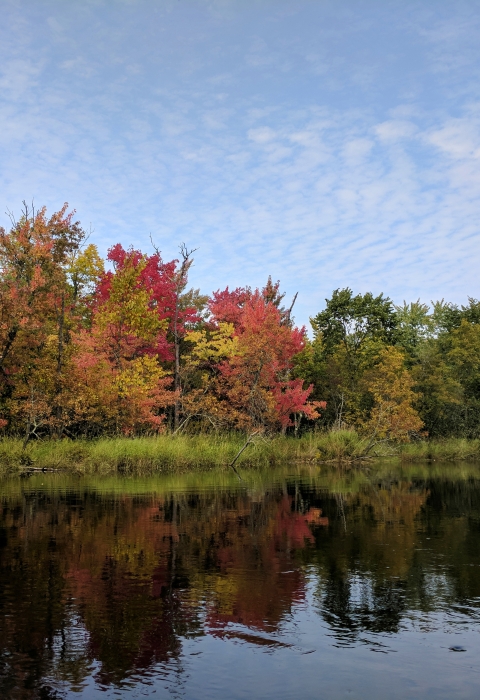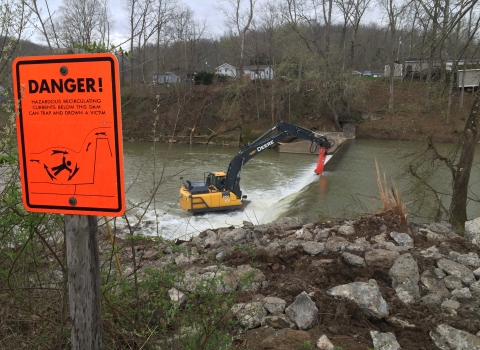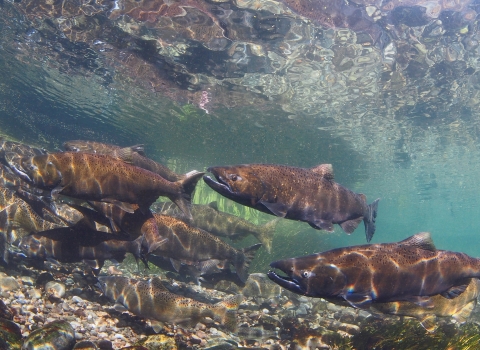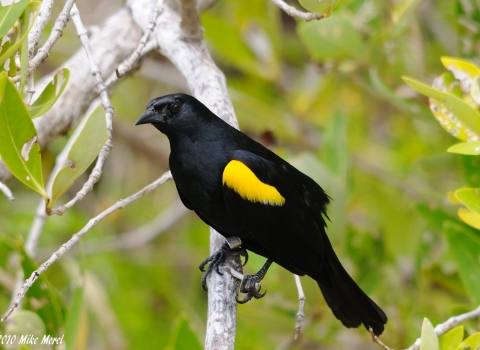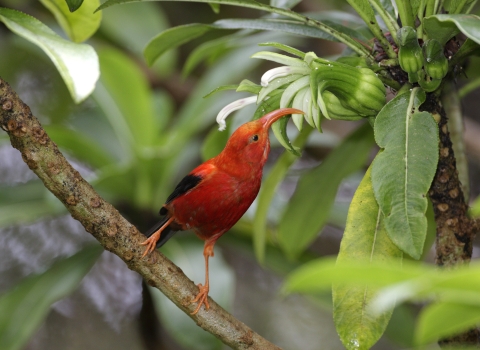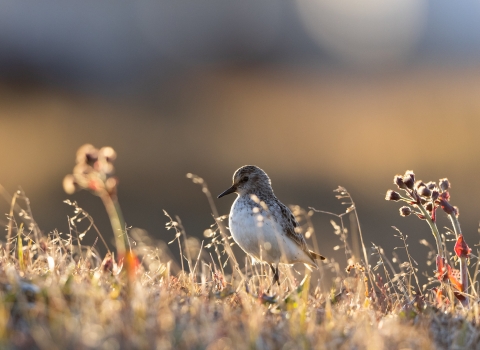Across the country, millions of dams and other barriers are fragmenting rivers, blocking fish migration and even putting communities at higher risk of flooding. Tens of thousands of dams in the U.S. are trapping fish into small sections of water which make it impossible for all types of aquatic animals to navigate, survive and reproduce. We at the U.S. Fish and Wildlife Service are happy to announce that this year, $70 million dollars will be invested across the nation in unplugging these blockages from our rivers.
Improving aquatic connectivity can be an effective way to help conserve vulnerable species while building safer infrastructure for communities, improving climate resilience, increasing recreational opportunities and strengthening local economies. That is why we are proud to announce that 43 additional rivers will be added to our ongoing work to revitalize waterways across the country.
The Midwest Region will see $15 million from the Bipartisan Infrastructure Law Bipartisan Infrastructure Law
The Bipartisan Infrastructure Law (BIL) is a once-in-a-generation investment in the nation’s infrastructure and economic competitiveness. We were directly appropriated $455 million over five years in BIL funds for programs related to the President’s America the Beautiful initiative.
Learn more about Bipartisan Infrastructure Law . These funds will be distributed between 10 projects across Illinois, Indiana, Michigan, Minnesota, Missouri and Ohio.
Learn about our projects in the midwest:
- Sangamon County Dam Removals, Illinois (USFWS: $1,500,000; Leverage: $1,500,000) The U.S. Fish and Wildlife Service will work with Illinois Department of Natural Resources and partners to remove two dams, the Riverside and Color Plant Dams, located on the Sangamon River in Springfield, Illinois. The removal of these two dams will reconnect a total of 55 miles of the Sangamon River upstream to the Lake Decatur Reservoir Dam in Decatur, Illinois. The removal of the Riverside and Color Plant dams will allow open river access to an additional 55 miles upstream on the Sangamon River and 55 miles of the South Fork of the Sangamon River, benefitting countless miles of small streams and tributaries that feed the river. In addition to reducing river fragmentation, the dam removals will also enhance water and habitat quality, enhance species diversity, increase climate resiliency, reduce public safety issues, and improve and expand recreational opportunities like fishing and kayaking.
- Emrichsville Dam Removal, Indiana (USFWS: 750,000; Leverage: $375,000) The U.S. Fish and Wildlife Service will work with Indianapolis Department of Public Works and partners to open up 37 miles of fish passage fish passage
Fish passage is the ability of fish or other aquatic species to move freely throughout their life to find food, reproduce, and complete their natural migration cycles. Millions of barriers to fish passage across the country are fragmenting habitat and leading to species declines. The U.S. Fish and Wildlife Service's National Fish Passage Program is working to reconnect watersheds to benefit both wildlife and people.
Learn more about fish passage . The Emrichsville Dam is approximately 250-feet-long and 8-feet-tall in the West Fork White River in Indianapolis. Full removal of this dam is proposed and will provide unrestricted fish passage, ecological resilience, mitigate effects of climate change climate change
Climate change includes both global warming driven by human-induced emissions of greenhouse gases and the resulting large-scale shifts in weather patterns. Though there have been previous periods of climatic change, since the mid-20th century humans have had an unprecedented impact on Earth's climate system and caused change on a global scale.
Learn more about climate change , increase safe recreational fishing, provide economic development and improve safe recreational uses of the river. - Flatrock River Dam Removals, Indiana (USFWS: $265,000; Leverage: $150,000) The U.S. Fish and Wildlife Service will work with Ecosystems Connections Institute, LLC and partners to remove two dams on the Flatrock River in central Indiana. Removal of these two dams will reconnect 141 stream miles, improve biological community structure structure
Something temporarily or permanently constructed, built, or placed; and constructed of natural or manufactured parts including, but not limited to, a building, shed, cabin, porch, bridge, walkway, stair steps, sign, landing, platform, dock, rack, fence, telecommunication device, antennae, fish cleaning table, satellite dish/mount, or well head.
Learn more about structure and function for priority species, make the stream safe for recreational use and mitigate effects of climate change. The Flatrock River supports 77 fish species, 27 freshwater mussel species and has a vibrant smallmouth bass fishery. - Kallio Creek at Skanee Road Aquatic Organism Passage Restoration, Michigan (USFWS: $ $600,142; Leverage: $300,000) The U.S. Fish and Wildlife Service will work with the Keweenaw Bay Indian Community and partners to replace the full aquatic organism barrier at Kallio Creek at Skanee Road. This project will restore aquatic passage and natural stream function at this site. This project will reconnect more than 3 miles of high-quality trout habitat in Kallio Creek to 25 miles of the Silver River. A new crossing structure will be designed to improve flood resiliency by passing at least the modeled 100-year flood with at least 20% freeboard and improve human safety in the river.
- Increasing Arctic Grayling Fish Passage in Upper Manistee River, Michigan (USFWS: $2,500,000; Leverage: $1,279,000) The U.S. Fish and Wildlife Service will work with Michigan Department of Natural Resources and partners to replace six improperly-sized and failing road-stream crossings that are barriers to aquatic organism passage in the Upper Manistee River. This is a priority watershed for restoration of Arctic Grayling and a state-designated natural river. The project will increase connectivity and quality stream habitat across 25 miles of river, prevent annual erosion of about 8 tons of sediment and install more climate adapted and resilient bridges and culverts designed to pass increased flood-flows. Target aquatic species are an assemblage of climate vulnerable cold-water fisheries resources, including arctic grayling.
- Removal of Peninsular Paper Dam, Michigan (USFWS: $800,000; Leverage: $4,596,654) The U.S. Fish and Wildlife Service will work with the City of Ypsilanti to remove Peninsular Paper Dam in Ypsilanti, Michigan. This project will restore the current impoundment to a freely flowing river channel and open up 2 miles of Huron river for fish passage. The dam is a high-hazard dam in poor condition. Removing the dam will have positive impacts on federally endangered freshwater mussels, create recreational opportunities and improve public safety the community.
- Crystal River Fish Passage and Restoration, Michigan (USFWS: $400,000; Leverage: $1,400,000) The U.S. Fish and Wildlife Service will work Conservation Resource Alliance and partners to replace a severely undersized stream crossing structure in Crystal River that is blocking off more than 2 miles of pristine habitat and is impacting riparian riparian
Definition of riparian habitat or riparian areas.
Learn more about riparian wetlands and stream substrates for more than 2,000 linear feet. The affected section of the river flows through the Sleeping Bear Dunes National Lakeshore, containing state-listed freshwater mussels and species of fish including northern pike, white sucker, smallmouth bass, largemouth bass and yellow perch. This section of river experiences more than15,000 recreational watercraft trips per season and carrying vessels over this stream crossing risks collisions with motor vehicles, while putting excess stress on the stream bed and stream banks. - Upper Otter Tail River Connectivity, Minnesota (USFWS: $3,906,000; Leverage: $2,222,222) The U.S. Fish and Wildlife Service will work with the Minnesota Department of Natural Resources and partners to reconnect a recovering native lake sturgeon population to 20 miles of critical spawning habitat, while furthering efforts to reconnect upstream Tribal restoration areas to the broader Red River Basin population recovery effort. This will be accomplished by replacing two undersized culverts with two span bridges where the U.S. Highway 10 divided expressway crosses the Otter Tail River. The present culverts create high velocities impassible to fish during the critical spring spawning period. The restored channel will restore fish passage, improve sustainability of culturally significant fish populations for local Tribes and contribute to regional transportation improvements.
- Huzzah Creek, Missouri Fish Passage Program, Missouri (USFWS: $1,459,850; Leverage: $570,000) The U.S. Fish and Wildlife Service will work with Crawford County Commission and partners to remove two Huzzah Creek fish passage barriers and replace them with climate resilient bridges located at John Coleman and Seller roads. Removing these barriers builds on a recent Huzzah National Fish Passage Program aquatic organism passage project, will restore natural hydrological conditions, and provide open passage to an additional 25 miles of stream habitat for the benefit of federally listed species, including endangered eastern hellbender. Endangered mussel species, such as pink mucket, scaleshell, snuffbox and spectaclecase will also benefit. Mussel hosts species such as logperch and freshwater drum, as well as smallmouth bass and other game species will see postive impacts. People benefit too, with local communities seeing reduced maintenance costs, increased safety and greater access for both public and emergency vehicles during high-flow events.
- Middle Great Miami River Restoration Project, Ohio (USFWS: $3,000,000; Leverage: $9,250,000) The U.S. Fish and Wildlife Service will work with Ohio Environmental Protection Agency and partners to remove two low dams, reconnect a more than a mile-long oxbow channel and create a bank to bank nature-like fishway riffle across a 12-foot-tall sheet pile dam that provides drinking water for the town of Piqua. This proposal is part of a larger initiative to provide fish passage in the entire upper watershed of the Great Miami River and reconnect 80 stream miles for state and federal species of interest. The dam removal and fishway projects will eliminate barriers to fish passage, eliminate safety hazards, reduce flood risk and increase recreational opportunities.
